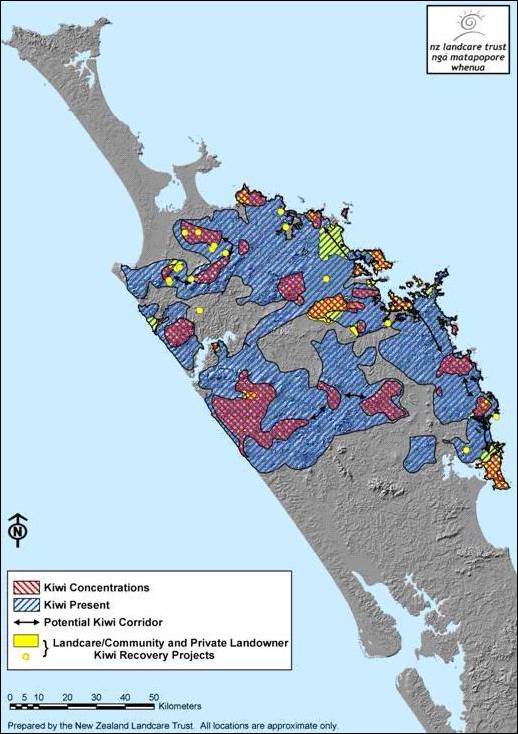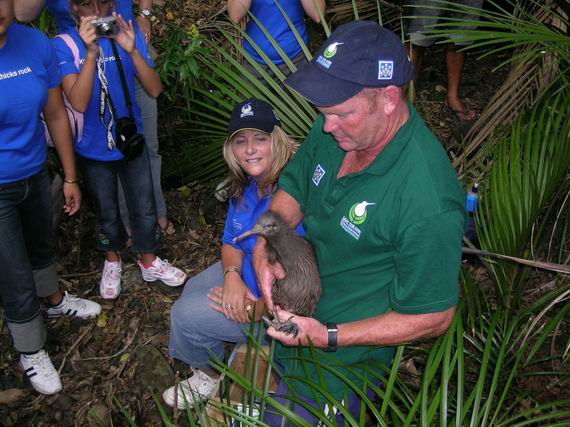15.7 Case study 1:Kiwi Protection in Northland
Initiatives to protect North Island kiwi (Apteryx mantelli) in Northland are a good example of how various government and non-government agencies, community groups and individuals can work together to protect a species at a regional level.
Kiwi populations in Northland have declined greatly due to loss of habitat, predation and impact of motor vehicles. Predators continue to pose the greatest threat to kiwi populations. Stoats, dogs, ferrets and cats are the key predator species, with possums and pigs also having an impact. Of these stoats and dogs have by far the largest impact on kiwi populations, with stoats being the major predator of kiwi eggs and chicks and dogs being the major killer of kiwi adults. In areas where there is no active predator control underway less than 6% of kiwi chicks will survive to maturity and kiwi will eventually disappear.
Protection initiatives
The report ‘Sustainable Management of Brown Kiwi' was produced in 2006 by Wildland Consultants (contract report No. 1193) for the NZ Landcare Trust and the Department of Conservation. This report highlights existing knowledge of kiwi populations in Northland, threats and management methods, current management efforts underway in the region and suggestions for future management. Much of the information in this case study has been sourced from this report.
Kiwi are an iconic species in New Zealand and Northlanders are fortunate that they are still able to see kiwi in the wild. Concerns over the decline in kiwi numbers and the very real prospective of losing kiwi from mainland Northland have led to a massive effort from many in the community to reverse the trend. The efforts that are underway are a good example of how different sectors of the community can work together for a common goal. Protection efforts take place on a number of different levels, it is important that on the ground efforts by landcare groups and individual landowners are supported with technical support, advocacy, research, planning, legislation and funding.
Kiwi populations are currently being managed at about 30 sites across Northland, as shown in figure 6 (below). This covers at least 53,000 ha and includes most of the identified population clusters. Thanks to these efforts, the kiwi population in Northland in these managed areas is increasing. Since 1999 call rates from kiwi monitoring have stabilised, with an increase in call rates at one of the four areas monitored.
The success of protection efforts is dependent upon ongoing collaboration between the various parties involved. Advocacy and education efforts from DOC, BNZ Save the Kiwi, NZ Landcare Trust and NZ Kiwi Foundation help to raise awareness of threats to kiwi and how to reduce these threats. Methods used include working with individual landowners, assisting communities to establish and run landcare groups, offering advice through field days and workshops and working with schools.

Figure 6: Kiwi clusters and kiwi management areas in Northland. Map courtesy of NZ Landcare Trust (Mullouly 2007).
The success of work on the ground is dependent upon effective predator trapping being carried out over a wide area, in many cases this requires the involvement of multiple landowners. Landcare groups provide a means to coordinate efforts and assist landowners in learning how to effectively carry out predator control and seek funding where needed. Community groups often carry out integrated pest management targeting a range of pest species. Concentrating solely on mustelid control (stoats, weasels and ferrets) is likely to lead to an increase in rats and mice and possibly possums. Targeting possums and possibly rats at the same time will benefit a range of indigenous species but traps and toxins need to be used in a manner that is safe for kiwi.
Funding to assist groups and individual landowners can come from a number of sources. The Northland Regional Council provides funds to assist with predator control through the Environment Fund and through funding of Community Pest Control Areas. Funding for groups to carry out predator control work in Northland has also come from the Department of Conservation Biodiversity Condition Fund, WWF Habitat Protection Fund, Transpower Landcare Trust Grants and BNZ Save the Kiwi. Funding has been used by a number of groups to purchase traps and toxins; some larger groups have managed to obtain funding to employ professional trappers to assist with their projects.

Kiwi being released as part of Operation Nest Egg and the Save the Kiwi initiative. Photograph courtesy of Helen Moodie.
District Councils within the region are utilising the information that is available on Northland kiwi distribution when processing subdivision applications. There are a number of sub-divisions that are either dog free, or cat and dog free.
What can you do?
If you live in an area where kiwi are still present there are a number of steps you can take to help ensure their survival.
· Contact the NZ Landcare Trust or the local DOC area office to find out if there are any community groups already involved in kiwi protection work in the area. You may wish to become involved in kiwi call monitoring or assist with trapping or allow others access to your land to carry out predator control work.
· Control dogs and cats. Dogs in particular are a major threat to kiwi populations and kill large numbers of birds each year. Kiwi have a very strong scent that is attractive to dogs and their lack of sternum and undeveloped chest muscles makes them particularly vulnerable to being crushed in a dog's mouth. Dogs of all sizes and breeds are capable of killing kiwi, so keep dogs under control at all times. Ask contractors working on your property not to bring dogs to work. Put a dog-free clause in any rental agreement. People pig hunting with dogs in areas where kiwi are present need to take extra care with how they manage their dogs.
· If pine forests are to be harvested or indigenous vegetation cleared steps can be taken to minimise the risk to any birds that are present.
